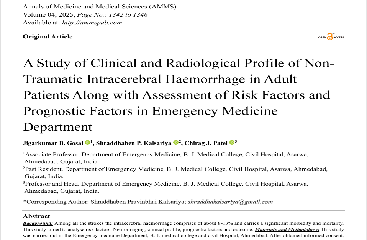A Study of Clinical and Radiological Profile of Non-Traumatic Intracerebral Haemorrhage in Adult Patients Along with Assessment of Risk Factors and Prognostic Factors in Emergency Medicine Department
Authors
##plugins.themes.bootstrap3.article.main##
Abstract
Background: Among all the strokes the intracerebral haemorrhage comprises of about 8-13% and carries a significant morbidity and mortality. This study aimed to analyse risk factors, Neuroimaging, clinical profile, prognostic factors and outcome. Materials and Methodology: This study was carried out in the Emergency medicine Department, B. J. medical college and civil Hospital, Ahmedabad. After obtained informed consent, 200 Patients were evaluated by history, clinical examination, presenting signs and symptoms. The onset stroke severity was assessed by GCS and NIHS Scale. CT scan or MRI brain was reviewed for intracerebral haemorrhage location, volume and intraventricular extention. The final outcome at discharge was evaluated by GOS and MRS. Results: The most important factors predicting the final outcome were size, location of haematoma, NIHSS, GCS and ICH score. High ICH score, NIHSS and low GCS at the time of admission were significantly associated with poor clinical outcome(p<0.05). 125(62.5%) patients had good outcome and 75(37.5%) had poor outcome with GOS Score <4. According to MRS Scale, 122(61%) patients had good outcome and 78(39%) had poor outcome with MRS Scale >4. Conclusion: All the patients were prognosticated on the basis of GCS, NIHSS, ICH, MRS, GOS Scores calculated on admission and discharge. The mean age was 56.8 years. Hypertension was the most common risk factor. Both the outcome score values were almost similar in this study, validating the scoring system for prognostication.
##plugins.themes.bootstrap3.article.details##
Copyright (c) 2025 Jigarkumar B. Gosai, Shraddhaben P. Kalsariya, Chirag J. Patel

This work is licensed under a Creative Commons Attribution 4.0 International License.
Creative Commons License All articles published in Annals of Medicine and Medical Sciences are licensed under a Creative Commons Attribution 4.0 International License.
Jigarkumar B. Gosai, Associate Professor, Department of Emergency Medicine, B. J. Medical College, Civil Hospital, Asarwa, Ahmedabad, Gujarat, India.
MD, Anaesthesia; Associate Professor, Department of Emergency Medicine, B. J. Medical College, Civil Hospital, Asarwa, Ahmedabad, Gujarat, India.
Shraddhaben P. Kalsariya, Past Resident, Department of Emergency Medicine, B. J. Medical College, Civil Hospital, Asarwa, Ahmedabad, Gujarat, India.
MD, Emergency Medicine
Past Resident, Department of Emergency Medicine, B. J. Medical College, Civil Hospital, Asarwa, Ahmedabad, Gujarat, India.
Chirag J. Patel, Professor and Head, Department of Emergency Medicine, B. J. Medical College, Civil Hospital, Asarwa, Ahmedabad, Gujarat, India.
MS, General Surgery
Professor and Head, Department of Emergency Medicine, B. J. Medical College, Civil Hospital, Asarwa, Ahmedabad, Gujarat, India.
[1] Mant J, Wade D.T, Winner S. 2004. Health care needs assessment: stroke. In: Stevens A, Raftery J, Mant J. et al. editors. Health care needs assessment: the epidemiologically based needs assessment reviews. First series, 2nd edition. Oxford: Radcliffe Medical Press, p141–244.
[2] O’Donnell MJ, Xavier D, Liu L, Zhang H, Chin SL, Rao-Melacini P, et al. Risk factors for ischaemic and intracerebral haemorrhagic stroke in 22 countries (the INTERSTROKE study): a case-control study. Lancet. 2010;376:112–123.
[3] Tintinalli's Emergency Medicine: A Comprehensive Study Guide, 9e Tintinalli JE, Ma O, Yealy DM, Meckler GD, Stapczynski J, Cline DM, Thomas SH. Tintinalli J.E., & Ma O, & Yealy D.M., & Meckler G.D., & Stapczynski J, & Cline D.M., & Thomas S.H.(Eds.),Eds. Judith E. Tintinalli, et al.
[4] Zhu XL, Chan MSY, Poon WS: Spontaneous intracranial haemorrhage: which patients need diagnostic cerebral angiography? A prospective study of 206 cases and review of the literature. Stroke 28: 1406, 1997.
[5] An SJ, Kim TJ, Yoon BW. Epidemiology, Risk Factors, and Clinical Features of Intracerebral Haemorrhage: An Update. J Stroke. 2017 Jan;19(1):3-10.
[6] Nag C, Das K, Ghosh M, Khandakar MR. Prediction of clinical outcome in acute haemorrhagic stroke from a single CT scan on admission. N Am J Med Sci. 2012;4:463-67.
[7] Hemphill, J. C., Bonovich, D. C., Besmertis, L., Manley, G. T., & Johnston, S. C. (2001). The ICH score: A simple, reliable grading scale for intracerebral haemorrhage. Stroke, 32(4), 891-897.
[8] Siddaganga, Konin BL, Bhat S. Clinical and Radiological Profie in Non Hypertensive Intracerebral HaemorrhageA Prospective Observational Study. Journal of Clinical and Diagnostic Research. 2022;16(8):OC33-OC36.
[9] Suthar NN, Patel KL, Saparia C, Parikh AP. Study of clinical and radiological profie and outcome in patients of intracranial haemorrhage. Ann Afr Med. 2016;15(2):69-77.

